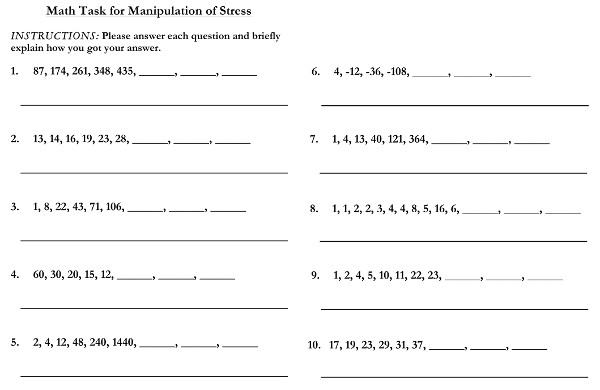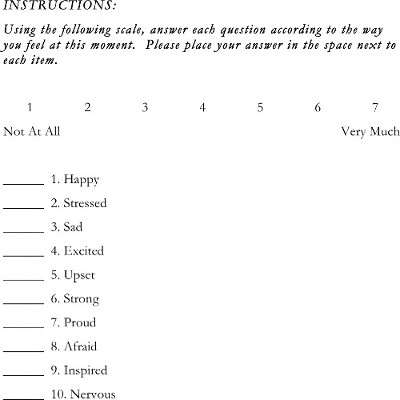Pilot Testing
Source: Laboratories of Gary Lewandowski, Dave Strohmetz, and Natalie Ciarocco—Monmouth University
In any experiment researchers have the challenge of creating experiences for participants that are consistent (i.e., reliable) and authentic (i.e., valid). Yet there are many ways to manipulate any one variable. For example, if you want participants to feel sad, you can have them think of their own sad memory, watch a sad video, or read a sad story.
Researchers must find the best way to operationalize a psychological construct in order to produce the most effective manipulation possible. Often, before running the main study, researchers will pilot test (i.e., try out) their manipulations to check their effectiveness.
This video demonstrates how to operationalize the same independent variable (acute stress) in three different ways. Specifically, this study seeks to identify the best sound (static, ticking clock, or crying baby) to play during a difficult task (solving complex math problems) to optimally manipulate stress.
Psychological studies often use higher sample sizes than studies in other sciences. A large number of participants helps to ensure that the population under study is better represented and the margin of error accompanied by studying human behavior is sufficiently accounted for. In this video, we demonstrate this experiment using just three participants, one for each condition. However, as represented in the results, we used a total of 120 (40 for each condition) participants to reach the experiment’s conclusions reflected in the Results section.
1. Define key variables.
- Create an operational definition (i.e., a clear description of exactly what a researcher means by a concept) of stressful sound.
- For the purposes of this experiment, a stressful sound is any noise that creates a feeling of tension, immediacy, or anxiety within participants.
- This will be manipulated through three different sounds: static, ticking clock, and a crying baby.
- For the purposes of this experiment, a stressful sound is any noise that creates a feeling of tension, immediacy, or anxiety within participants.
- Create an operational definition (i.
The researcher used 40 participants per condition, and as a result, collected data from 120 participants overall. Numbers above reflect the mean reported stress levels that participants indicated on the 1-7 scale for the stressed item in each condition. This multi-group experiment showed how researchers can operationalize the same construct in multiple ways.
A large number of participants is necessary to ensure that the results are reliable. If this research were conducted using just a few par
The use of a pilot test helps researchers determine the most effective way to manipulate stress. With this knowledge, researchers can use the best manipulation in their future study.
For example, researchers manipulated stress by having participants do easy or difficult math problems to determine how stress influenced relationship behaviors.1 The results indicated that those under stress were more likely to pay attention to alternate partners and were less likely to give their own p
- Lewandowski, G. W., Jr., Mattingly, B. A., & Pedreiro, A. Under pressure: The effects of stress on positive and negative relationship behaviors. Journal of Social Psychology. 154, 463-473. doi: 10.1080/00224545.2014.933162 (2014).
- Trammell, J. P., & Clore, G. L. Does stress enhance or impair memory consolidation? Cognition and Emotion. 28 (2), 361-374. doi:10.1080/02699931.2013.822346 (2014).
Skip to...
Videos from this collection:

Now Playing
Pilot Testing
Experimental Psychology
10.3K Views

From Theory to Design: The Role of Creativity in Designing Experiments
Experimental Psychology
18.0K Views

Ethics in Psychology Research
Experimental Psychology
28.9K Views

Realism in Experimentation
Experimental Psychology
8.2K Views

Perspectives on Experimental Psychology
Experimental Psychology
5.6K Views

Observational Research
Experimental Psychology
12.9K Views

The Simple Experiment: Two-group Design
Experimental Psychology
71.4K Views

The Multi-group Experiment
Experimental Psychology
22.7K Views

Within-subjects Repeated-measures Design
Experimental Psychology
22.8K Views

The Factorial Experiment
Experimental Psychology
73.0K Views

Self-report vs. Behavioral Measures of Recycling
Experimental Psychology
11.7K Views

Reliability in Psychology Experiments
Experimental Psychology
8.4K Views

Placebos in Research
Experimental Psychology
11.6K Views

Manipulating an Independent Variable through Embodiment
Experimental Psychology
8.5K Views

Experimentation using a Confederate
Experimental Psychology
17.8K Views
Copyright © 2025 MyJoVE Corporation. All rights reserved

